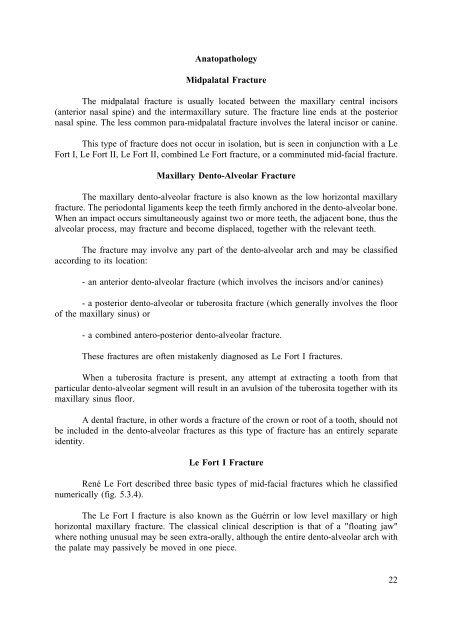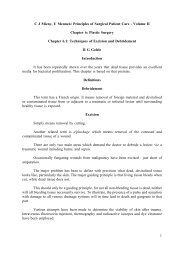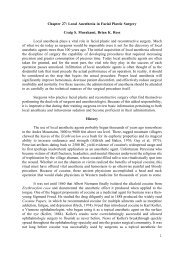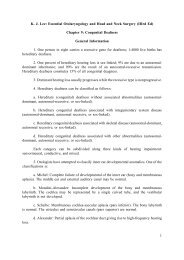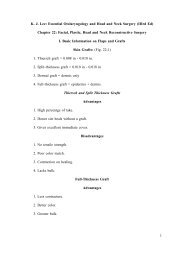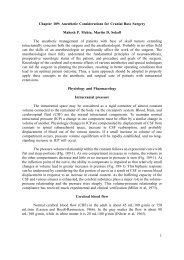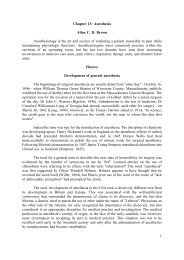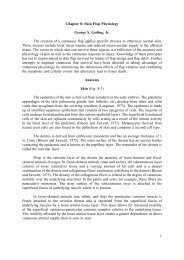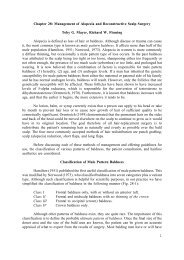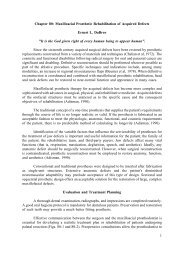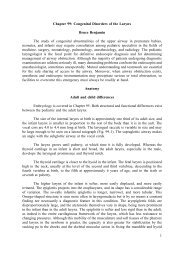1 C J Mieny, U Mennen: Principles of Surgical Patient Care - Volume ...
1 C J Mieny, U Mennen: Principles of Surgical Patient Care - Volume ...
1 C J Mieny, U Mennen: Principles of Surgical Patient Care - Volume ...
- No tags were found...
You also want an ePaper? Increase the reach of your titles
YUMPU automatically turns print PDFs into web optimized ePapers that Google loves.
AnatopathologyMidpalatal FractureThe midpalatal fracture is usually located between the maxillary central incisors(anterior nasal spine) and the intermaxillary suture. The fracture line ends at the posteriornasal spine. The less common para-midpalatal fracture involves the lateral incisor or canine.This type <strong>of</strong> fracture does not occur in isolation, but is seen in conjunction with a LeFort I, Le Fort II, Le Fort II, combined Le Fort fracture, or a comminuted mid-facial fracture.Maxillary Dento-Alveolar FractureThe maxillary dento-alveolar fracture is also known as the low horizontal maxillaryfracture. The periodontal ligaments keep the teeth firmly anchored in the dento-alveolar bone.When an impact occurs simultaneously against two or more teeth, the adjacent bone, thus thealveolar process, may fracture and become displaced, together with the relevant teeth.The fracture may involve any part <strong>of</strong> the dento-alveolar arch and may be classifiedaccording to its location:- an anterior dento-alveolar fracture (which involves the incisors and/or canines)- a posterior dento-alveolar or tuberosita fracture (which generally involves the floor<strong>of</strong> the maxillary sinus) or- a combined antero-posterior dento-alveolar fracture.These fractures are <strong>of</strong>ten mistakenly diagnosed as Le Fort I fractures.When a tuberosita fracture is present, any attempt at extracting a tooth from thatparticular dento-alveolar segment will result in an avulsion <strong>of</strong> the tuberosita together with itsmaxillary sinus floor.A dental fracture, in other words a fracture <strong>of</strong> the crown or root <strong>of</strong> a tooth, should notbe included in the dento-alveolar fractures as this type <strong>of</strong> fracture has an entirely separateidentity.Le Fort I FractureRené Le Fort described three basic types <strong>of</strong> mid-facial fractures which he classifiednumerically (fig. 5.3.4).The Le Fort I fracture is also known as the Guérrin or low level maxillary or highhorizontal maxillary fracture. The classical clinical description is that <strong>of</strong> a "floating jaw"where nothing unusual may be seen extra-orally, although the entire dento-alveolar arch withthe palate may passively be moved in one piece.22


